The OnePlus 8, OnePlus 8 Pro Review: Becoming The Flagship
by Andrei Frumusanu on June 29, 2020 10:00 AM ESTDisplay Measurement
The OnePlus 8 and 8 Pro feature brand new display panels that represent the best in their respective categories. Since the OnePlus 7 Pro, the company has been able to source amongst the best and cutting-edge panels from Samsung, and the OnePlus 8 Pro is no different. Using the latest emitter technologies, a 1440p resolution and a 120Hz refresh rate, there’s very little to be wished for in the display of the new flagship.
The OnePlus 8 has an equally excellent screen, however with its 90Hz and 1080p resolution is just shy of having the best specifications.
We move on to the display calibration and fundamental display measurements of the OnePlus 8 and OnePlus 8 Pro screens. As always, we thank X-Rite and SpecraCal, as our measurements are performed with an X-Rite i1Pro 2 spectrophotometer, with the exception of black levels which are measured with an i1Display Pro colorimeter. Data is collected and examined using Portrait Display's CalMAN software.

In daylight, both phones have excellent brightness reaching up till around 800nits on full-screen white content, representing the best results we’ve measured on an OLED panel, just shy of the LG G7’s ultra-bright LCD screen. Under manual brightness the phone reach about 430 nits.
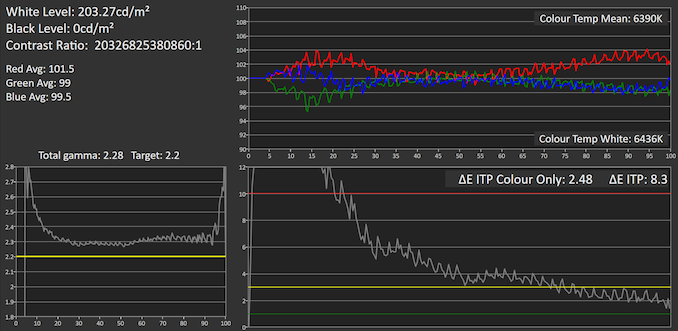
 Portrait Displays CalMAN
Portrait Displays CalMAN
OnePlus 8
On the regular OnePlus 8, the phone has good colour temperature although the reds are only every so slightly above a perfect grade. The display’s gamma curve however is a tad more off with too high a total gamma of 2.28, making tones appear darker than they should be. This seemingly is especially present in the lower intensity tones as the phone clips a lot of content to black or near-black.
The zig-zagging measurement results here are pointing out to some sort of artefac of the screen calibration which is a bit abnormal, but something we did see on occasion happen on some devices in the past.

 Portrait Displays CalMAN
Portrait Displays CalMAN
OnePlus 8 Pro
On the OnePlus 8 Pro, the gamma results are significantly better and the phone is able to track nearer to the optimal 2.2 target. The 8 Pro’s biggest issue though is colour balance as in the natural profile things are far too much dominated by reds – or rather say a lack of blue. The average colour temperature ends up at 6216K and pure whites end up in a quite disappointing 6155K which is pretty much immediately visible on the phone.
sRGB saturation accuracy of the OnePlus 8 is quite good and we end up with an overall dEITP of 2.75 which is within the imperceptible margin for most users.
The OnePlus 8 Pro’s colour accuracy isn’t nearly as good. We’re seeing worse results across the board and when looking at the gamut results this seems to be due to too weak blue tones, shifting the whole cyan-blue-magenta saturations from where they should be. The most noticeable effect of this is again in whites where they’re far too warm.
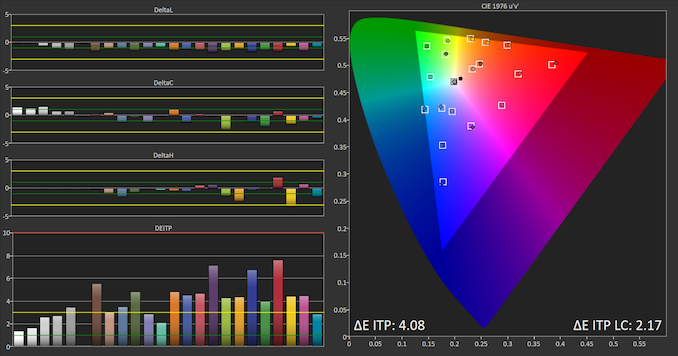
 Portrait Displays CalMAN
Portrait Displays CalMAN
OnePlus 8
In the Gretag MacBeth colour chart with most common tones and skin colours, the OnePlus 8 fares well in terms of its colour accuracy, only being more handicapped by its higher gamma target which makes all tones appear darker than they should be. Overall, it’s still an excellent result for the phone.

 Portrait Displays CalMAN
Portrait Displays CalMAN
OnePlus 8 Pro
The OnePlus 8 Pro nails the luminance component of the test patches, however it has more significant hue and saturation deviations that more easily stand out to the eye
Overall Display Conclusion
Both the OnePlus 8 and 8 Pro have excellent displays. The 90Hz and 120Hz refresh rate capabilities of the phones is what really makes them stand out in everyday usage. In terms of colour accuracy, things aren’t at all perfect. The OnePlus 8 has issues with the gamma curves, having a too high target resulting in too dark tones, especially at the lower intensity levels where things can clip to black.
The OnePlus 8 Pro’s issues are more severe as whilst its gamma is good, it has more noticeable problems with some hues and especially saturations in the blue spectrum. The biggest issue is its far too warm colour temperature with whites falling in at only 6150K. OnePlus likes to brandish awards regarding the device’s screen accuracy, but legitimacy of such figures always come in question as such cherry-picked results never match proper independent analysis. Nevertheless, you can set up a manually adjusted colour temperature that will solve the main negative about the screen.


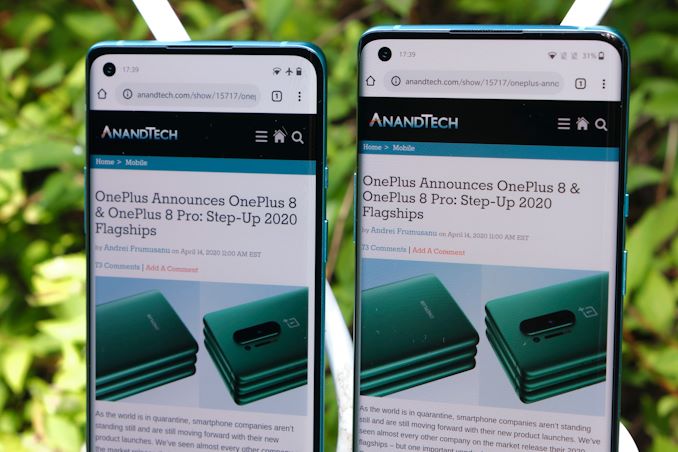
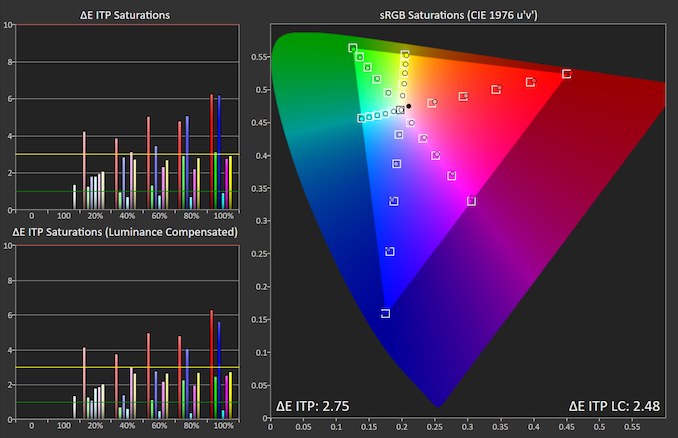
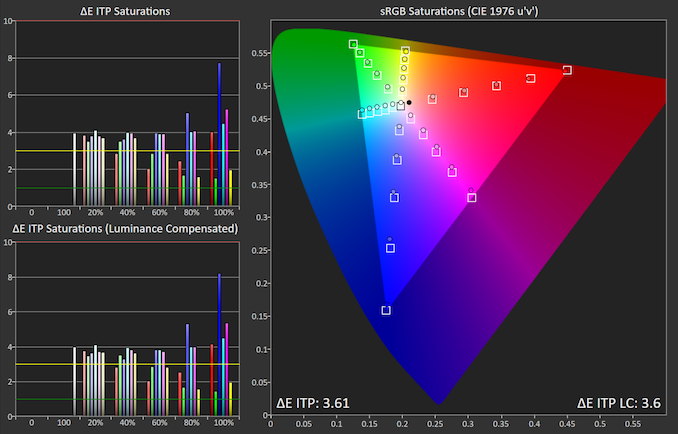








92 Comments
View All Comments
Dexter101 - Monday, June 29, 2020 - link
I feel like the conclusion leaves out some details on pricing. You can compare the MSRP prices and come to conclusions but in 1 month or so the first big deals will start showing up for Samsung flagships with heavy price drops. You'll be able to get an S20+ for less than 700€ then, while the OnePlus phones stay true to their MSRP pricing year round.Considering the quality control issues, the 200€ you save on the Samsung and the generally less buggy software I would likely go for the S20+, although the Snapdragon in all markets is a good advantage in Europe for Oneplus!
Andrei Frumusanu - Monday, June 29, 2020 - link
I compared it at current street prices - the price drops already happened.PeachNCream - Monday, June 29, 2020 - link
In order to be a flagship, generally said thing should be able to float on water and support fly the fleet commander's flag. I suppose Anandtech tested both of those requirements in order to verify the accuracy of the claim as such for the OnePlus 8, but publishing the benchmark data and testing methods used would be good journalism. Also, pics of the command center from which fleet operations are coordinated inside of the OnePlus 8 would be a nice addition to this review given the high importance of tossing about the term "flagship" in even opening the article.eastcoast_pete - Monday, June 29, 2020 - link
Actually, regarding the ability to float: that is a key problem with many (all?) protective cases! What good does IP68 etc. do me if the damn phone (in its protective case) will still sink to the bottom of whatever body of water one is on or close to? I haven't dropped my phone into the sea yet, but friends of mine have while out fishing. So, any protective cases that will let the $ 1,000 smartphone float?Omair - Monday, June 29, 2020 - link
Hi Andrei, The 8 pro actually supports 10W Qi Wireless Charging, not 5W. You can verify it on the Wireless Power Consortium's Website: https://www.wirelesspowerconsortium.com/products/8...Of course, the charger will need to support Qi's Extended Power Profile to get 10W, which most don't (They usually only support 5W Qi, and then Samsung's and Apple's fast charge above that).
But if the charger is advertised as doing 10W on LG, Sony, or Xiaomi phones, it will most likely do 10W on the 8 pro. You can also just check the charger on the WPC's website and see what wattage is listed.
ads295 - Monday, June 29, 2020 - link
I think we're well past the point where meaningful differences in computing hardware made much difference, such as the jump Samsung made with the Exynos 7420 in the GS6, or the jump from eMMC to UFS storage. Even for screen resolution for a 5.5-6" display, you can't get much better than 1440p at 90Hz. At this point companies should focus ONLY on the differentiating features, such as putting in a huge battery (path breaking to have a thicker phone that last long), better camera (no one has perfected this yet), better phone protection (less snowflake), and other tiny lil goodies such as an IR port, heart rate sensor, SpO² sensor that actually are different.ads295 - Monday, June 29, 2020 - link
But it's as if no one has realised this and people are willing to overpay for LaTeSt CPU BrO and MoAr JiGgAbYtEs and establishing phallic measurements.Alistair - Monday, June 29, 2020 - link
They raised the price on the base model from $700-$800 (depending on launch time frame) to $1100 in Canada. Oneplus is dead. Failed company, a huge disappointment. I finally bought an iPhone for the first time, saved a ton of money. How far Android has fallen in the last 5 years in price and quality is sad.alufan - Monday, June 29, 2020 - link
Agree Android is in trouble, Google has let it down badly by allowing all these suppliers to make so much bloat on handsets after starting with the very first Android and now on a S20 Ultra which frankly is rubbish compared to my mate 30pro I had before I think my next phone will be an Apple, I use one for work and whilst its frustrating due to the lack of or ease of customisation options fact is it just works on Android I have 2 calenders, 2 Music players, 2 browsers, I could go on I want to uninstall the Samsung browser and bixby etc etc but I cant, its my goddam device i want them off but you cant and if I root it then my bank apps no longer work...great way to keep customers GoogleAlistair - Tuesday, June 30, 2020 - link
What is especially worrying is the price bloat. Snapdragon and various Android phone part suppliers seem to be upping their prices dramatically. A Snapdragon 865 should be a lot cheaper and we're hearing rumors they want to charge even more for next year.